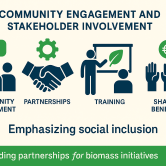When most people hear “biomass,” they think of renewable energy—heat and power generated from plant and animal materials. While this is a crucial benefit, a silent revolution is underway, transforming biomass from a mere energy source into the cornerstone of a self-sustaining rural circular economy. This paradigm shift moves beyond a “take-make-dispose” model to a closed-loop system where waste is designed out, and resources are continuously repurposed, bringing unprecedented economic and environmental resilience to farming communities.
The concept of a circular economy is at the heart of the European Union’s long-term strategic vision. As articulated in the European Green Deal and its Circular Economy Action Plan, the goal is to create a “regenerative growth model that gives back to the planet more than it takes” (European Commission, 2020). For rural areas, this means leveraging local bio-resources to create value chains that keep wealth and jobs within the community.
From Agricultural “Waste” to Value-Added Products
The linear model often views agricultural residues like straw, manure, and pruning waste as a disposal problem. In a circular bioeconomy, these residues become valuable feedstocks. The process begins with anaerobic digestion (AD), a well-established technology that breaks down organic matter in the absence of oxygen.
- Energy Production: The primary output of AD is biogas, a mixture of methane and CO₂, which can be used to generate electricity and heat for local farms and businesses, or upgraded to biomethane and injected into the gas grid. This provides farmers with a diversified, stable income stream, insulating them from volatile crop and energy markets.
- Digestate: The Hidden Gem: After biogas is extracted, the remaining material, called digestate, is a nutrient-rich substance. As highlighted in a comprehensive review by Al Seadi et al. (2013), digestate is an excellent organic fertilizer, rich in readily available nitrogen, phosphorus, and potassium. By returning these nutrients to the soil, farmers close the nutrient loop, reducing their dependence on energy-intensive, synthetic fertilizers. This improves soil health, enhances soil organic carbon, and completes the cycle from field to energy and back to field.
The Academic Backing: Soil Health and Carbon Sequestration
The benefits are not merely operational; they are deeply ecological. Academic research reinforces the role of organic fertilizers like digestate in building sustainable agricultural systems. A study published in Agronomy for Sustainable Development concluded that the long-term application of organic fertilizers significantly improves key soil health indicators, including soil structure, water-holding capacity, and microbial activity (Diacono & Montemurro, 2010). Healthier soils are more resilient to droughts and floods and act as a significant carbon sink, directly contributing to climate change mitigation—a core pillar of the EU’s Farm to Fork Strategy.
A Blueprint for Rural Entrepreneurs and VET Educators
For entrepreneurs and VET (Vocational Education and Training) educators, this circular model opens a wealth of opportunities:
- New Business Models: Opportunities exist not just in operating AD plants, but in logistics (collecting and transporting biomass), digestate processing and packaging, and providing consulting services on nutrient management plans.
- Curriculum Development: VET programs must now integrate circular economy principles, teaching future farmers and agricultural technicians about the economic valorization of residues, the agronomic value of digestate, and the environmental accounting of closed-loop systems.
Conclusion
The future of rural development lies in intelligent integration. By viewing biomass through the lens of the circular economy, we unlock a system where farmers become energy producers and stewards of their land, where waste becomes a resource, and where rural communities become hubs of innovation and sustainability. It’s a future where economic prosperity and ecological health are not competing goals, but two sides of the same leaf.




